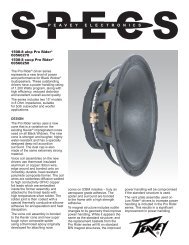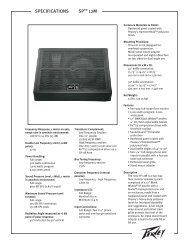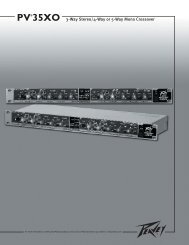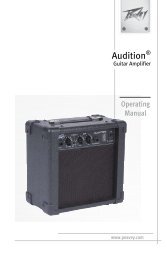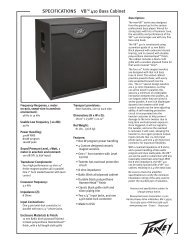tragic 4 pxd peavey
tragic 4 pxd peavey
tragic 4 pxd peavey
Create successful ePaper yourself
Turn your PDF publications into a flip-book with our unique Google optimized e-Paper software.
Changing Your Strings<br />
Unless you are reconditioning your fretboard (see care and<br />
cleaning), strings should be changed one at a time to maintain<br />
proper neck tension. New strings should be free of defects<br />
(twists, kinks, bends) that can cause sound irregularities or<br />
breakage. All strings are prone to stretch, particularly upon<br />
installation. After your first tuning, carefully pull each string<br />
away from the fretboard, stretching it gently (too much force<br />
will break thinner strings). Then, retune your guitar.<br />
Peavey recommends that you replace strings in the same<br />
gauges to maintain proper neck and/or bridge tension. If you<br />
wish to change strings with different gauges, Peavey recommends<br />
that you enlist the services of a qualified technician to<br />
make the required truss rod and/or bridge adjustments on your<br />
instrument.<br />
12<br />
Standard Tuning<br />
(thickest string to thinnest)<br />
4-String Bass Tuning<br />
Open note<br />
E A D G<br />
String 4 3 2 1<br />
5-String Standard Low B<br />
Adds one lower pitched string<br />
Open note B E A D G<br />
String 5 4 3 2 1<br />
5-String Alternative High C<br />
Adds one higher pitched string<br />
Open note E A D G C<br />
String 5 4 3 2 1<br />
6-String Bass Tuning<br />
Open note B E A D G C<br />
String 6 5 4 3 2 1





